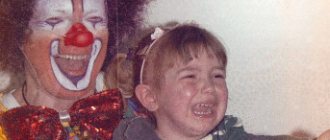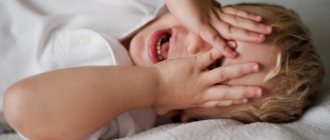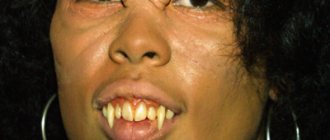Article:
Astheno-neurotic syndrome in children is a common pathology of the nervous system, which occurs as a result of overwork and severe emotional shock.
With neurasthenia, children look healthy, but tired. Symptoms of astheno-neurotic syndrome in children are similar to the clinical manifestations of depression, vegetative-vascular dystonia, and chronic fatigue.
People who are far from medicine do not know what astheno-neurotic syndrome in children is and how to treat this disease. It is often difficult for parents to suspect a nervous system disorder in their child, since they attribute moodiness, fatigue, and tearfulness to the child’s character traits. As a result, instead of helping a child suffering from a neurotic disorder, parents scold and punish him, aggravating the situation.
GENERAL INFORMATION ABOUT PATHOLOGY
Neurasthenia in children is a symptom complex that occurs as a result of exhaustion of the nervous system. The symptoms of neurasthenia in children differ from the signs of neurasthenia in adults.
Doctors call this disease irritable fatigue syndrome. Asthenoneurosis occurs not only in children, but also in adolescents. This disorder is one of the common causes of a decrease in a child’s school performance and conflict in relationships with peers and adults.
Asthenoneurosis can be a consequence of intrauterine pathology of the development of the nervous system, birth trauma, or an infection suffered by the baby in the early postnatal period. In this case, signs of the disease appear at 2–3 years. The disease can also develop at school age as a result of excessive stress on the nervous system.
Symptoms and signs of neurasthenia in children should be a reason to visit a doctor. Without timely treatment, they will lead to irreversible changes in the child’s psyche.
List of used literature
- Grishchenko E.V. Methods for correcting asthenic syndrome in outpatient practice // “medical council”, 2012 - p. 36-37
- Kolyutskaya E. V. Modern approaches to psychopharmacotherapy of anxiety disorders // Pharmaceutical Bulletin: information and analytical newspaper. 2005. - p. 112-116
- Vein L. M., Voznesenskaya T. G., Vorobyova O. V. et al. Autonomic disorders: clinical picture, treatment, diagnosis / ed. A. M. Veina. M.: medical information agency. - 1998. - 752 p.
SYMPTOMS OF THE DISEASE
Symptoms of the disease are associated with disturbances in the functioning of the nervous system. Clinical psychologists and psychiatrists classify the signs of the disease into 2 groups:
- Symptoms caused by disturbances in the functioning of the autonomic nervous system. Symptoms of this group include all physiological manifestations of neurasthenia: increased sweating, physiological dependence on sweets, enuresis, heart rate deviation from the average age norm, decreased blood pressure, decreased immunity to colds.
- Symptoms caused by disturbances in brain function. This group of symptoms includes behavioral manifestations of neurasthenia: causeless mood swings, inadequate reactions to the words and actions of others, poor control of emotional manifestations, sleep disturbances, a predominance of low mood, depression, decreased voluntary memory and concentration, motor disinhibition, and the appearance of various phobias.
SYMPTOMS IN CHILDREN 2–6 YEARS OLD
Astheno-neurotic syndrome in preschool children manifests itself in the form of:
- fearfulness, phobias, excessive impressionability;
- logoneurosis in the form of rapid speech and unclear sound pronunciation
- tearfulness, moodiness;
- irritability and short temper;
- unmotivated aggression towards peers, self-aggression;
- abuse of toys;
- tendency to tear, break, spoil things, books;
- restlessness and fussiness, motor disinhibition, obsessive movements;
- depressed mood;
- convulsive syndrome and nervous tics;
- restless sleep;
- loss of interest in favorite games, lethargy;
- psychosomatic manifestations (pain in the neck and arms, constipation).
SYMPTOMS IN SCHOOLCHILDREN
Symptoms of astheno-neurotic syndrome in school-age children are:
- irritability and nervous excitability;
- vulnerability, touchiness;
- isolation;
- fatigue, decreased performance;
- increased situational and personal anxiety and causeless worry;
- mood swings;
- panic attacks and phobias;
- decreased concentration of voluntary attention;
- a sharp decline in academic performance;
- headache;
- sleep problems;
- appetite disorder;
- Vivid emotional outbursts in the form of screaming, falling to the floor, hysterics.
Features of communication
Among all other character accentuations, the astheno-neurotic personality type is one of the most unpredictable in terms of communication. It may seem soft and sensitive at first. But then it turns out that he is subject to strong outbursts of anger and invents problems for himself and the people around him literally out of nowhere.
- Singles
They are friendly, but will always prefer loneliness to companies. And not because they avoid communication. They just quickly get tired of the noise, intrusive looks and questions.
- Mood swings
Because of their temper, they are often rude, rude and throw tantrums even to close people. When the outburst of rage passes, they begin to very sincerely ask for forgiveness, because they feel guilty.
- Not fighters
They do not like to argue and enter into conflicts. When such a situation arises, they immediately give up, without even accepting the fight.
Recommendations for communicating with an astheno-neurotic person:
- Avoid creating situations of conflict and competition.
- Do not be offended by rude things said during outbursts of rage. Wait patiently for them to finish and then talk calmly.
- Do not force an astheno-neurotic person to go to noisy parties and do not invite too many guests home.
- Do not get carried away with criticism, so as not to completely kill the desire to do something. Praise more, notice and highlight positive aspects. Take a position of leniency towards mistakes.
- Do not offer to watch horror films and melodramas. Comedies and something from the popular science genre are the few things that definitely won’t upset an asthenic-neurotic personality.
- In communication, be friendly and calm.
- No jokes or irony in his direction - he won’t understand, he’ll be upset or offended.
- Don't give surprises. No unexpected questions or meetings. Agree on everything in advance.
- Know the daily routine of an astheno-neurotic person and do not violate it.
In general, the secret of successful communication with people of the astheno-neurotic type is quite simple. It is better to plan the meeting around the middle of the day, somewhere from 11.00 to 15.00. In the morning they feel completely exhausted after the night - they need time to focus on their internal resources in order to complete the necessary tasks. When they get involved, they forget about illnesses and grievances. If they are not irritated at this moment, there is a calm atmosphere around, they are the nicest and kindest people. However, then they run out of steam, get tired and are no longer capable of adequate communication.
STAGES OF ASTHEN-NEUROTIC SYNDROME
The following stages are distinguished in the development of a neurotic disorder:
- Hypertensive neurasthenia. At this stage, the patient experiences increased excitability and irritability, emotional sensitivity, decreased efficiency in performing mental or physical labor, absent-mindedness, girdling headache, and sleep problems.
- Irritable weakness. The disease moves to the second stage if the patient ignored the initial signs of the disease and did not seek medical help. This stage is characterized by the fact that a person can no longer hide his irritability, his nervous system is quickly depleted. The patient cannot concentrate on the production or educational tasks facing him due to constant headaches and weakness in the body. A person feels overwhelmed in the morning.
- Hyposthenic neurasthenia. If you do not see a doctor at the second stage, the disease develops into stage 3. The patient develops chronic fatigue, sad mood, apathy, and drowsiness. Psychosomatic disorders appear: skin itching, hair loss, brittle nails, pain in the spine and joints, decreased hearing and visual acuity, exacerbation of chronic diseases.
Types according to ICD10
The international classification defines two main options for the development of pathology:
- Hyperdynamic. With this nature of the disease, increased excitability, absent-mindedness, disinhibition, and loss of attention are manifested. Also obvious signs are emotional instability and insomnia.
- Hypodynamic. Provokes reduced activity, bad mood, excessive calmness. The child exists inside his own world; he reacts weakly to the changing reality. There may be problems with speech development, inadequate perception of smells and extraneous sounds.
VARIETIES OF SYNDROME
Experts have come to the conclusion that astheno-neurotic syndrome in children is a disease that can be found in such forms as:
- Cerebrasthenic asthenoneurosis is a congenital pathology caused by organic lesions of the brain.
- Residual asthenia is a congenital type of neurosis that occurs as a result of pathology of the nervous system or as a result of a birth injury to the head. Manifestations of this type of disease are tearfulness, enuresis, and impaired fine and gross motor skills.
- Somatogenic asthenia is a type of psychosomatic illness. As a rule, this type of neurosis develops in children with a history of disturbances in the functioning of the digestive system in the form of gastritis and ulcerative lesions of the duodenum.
- Dysontogenetic asthenia, the main symptoms of which are chronic fatigue, low performance and poor concentration on an intellectual task.
- Psychosocial neurasthenia is a neurosis that arises as a consequence of an unfavorable situation in the family. In adolescence, this form of asthenia can develop as a result of the child’s rejection by his peers. This type of disease is manifested by insomnia and frequent headaches.
- Hyperdynamic asthenia is a form of neurotic disorder in preschool children. It manifests itself in the form of motor disinhibition, restlessness, and fussiness of the child.
- Hypodynamic asthenia is a type of neurosis in which the processes of inhibition in the nervous system prevail over the processes of excitation. The child is passive, inactive, immersed in his own inner world, avoids communication with peers and active games. The main cause of this type of disease is underweight or overweight, weak muscle tone, and a tendency to catch colds.
general characteristics
A brief description of the astheno-neurotic psychotype is determined by the following character traits and characteristics:
- increased fatigue;
- irritability, short temper, lack of restraint;
- often - bad mood;
- in the morning - drowsiness and “weakness”;
- hypochondria;
- sudden affective outbursts at the slightest, meaningless reason;
- emotional breakdowns when plans fail;
- accuracy;
- discipline, diligence, flexibility;
- low self-esteem;
- due to excessive fatigue - forgetfulness, lethargy, low activity;
- physical labor is more preferable than mental labor.
The astheno-neurotic type is included in the classification of character accentuations according to Lichko. Leonhard calls it anxious-fearful.
Recommended hobbies for an astheno-neurotic person are any collecting, as well as non-exhausting sports (like stretching or Finnish walking).
The most striking examples of famous fictional astheno-neurotics are Eeyore from Winnie the Pooh and Melman the giraffe from Madagascar.
An example from life. A young woman came to see a family psychologist. She recently married her colleague. They worked together for 2 years. At the same time, he was a very disciplined and efficient worker: he always submitted all reports on time, was never rude to anyone, and never gossiped with anyone. When they started dating, it seemed to her that he focused too much attention on himself, namely on his even the most minor ailments and problems. But overall, they had a good relationship and got married. After that, everything went wrong: after work, the husband literally fell on the sofa and got up only a couple of hours before bedtime to have a snack and take a shower. He was exhausted from any effort - both moral and physical. And, of course, the lion's share of the family budget began to go to his ghostly, most often fictitious, illnesses. She was tired of this and came to ask for advice from a psychologist, who explained to her that her husband was a typical representative of the astheno-neurotic psychotype.
CAUSES OF NERVOUS DISORDER
Asthenia can occur for the following reasons:
- genetic predisposition to nervous system disorders;
- melancholic or choleric type of temperament in a child;
- self-doubt, low self-esteem;
- asphyxia during childbirth or oxygen starvation of the fetus during intrauterine development;
- severe emotional distress of the mother during pregnancy;
- pronounced toxicosis during gestation;
- exposure of the fetus to toxic substances as a result of maternal use of medications, alcohol, or smoking during pregnancy;
- Rh conflict between mother and child;
- disruption of metabolic processes in the cerebral cortex as a result of neuronal pathologies and diseases of the meninges;
- cerebral palsy;
- spinal injuries;
- weakened immunity of the child;
- traumatic brain injury or infectious diseases during early childhood;
- increased intracranial pressure;
- meningitis, arachnoiditis and encephalitis;
- brain oncology;
- abnormalities in the functioning of the kidneys and liver;
- deficiency of B vitamins in the body;
- hormonal imbalance, pathology of the endocrine system;
- thyroid dysfunction;
- diabetes;
- prolonged exposure to stress or severe emotional shock;
- unfavorable psychological atmosphere in the family, conflicts in relationships with loved ones;
- excessive severity of parents, use of cruel methods of education against a child;
- low socio-psychological status of the child in the group of peers;
- difficulties in socializing and adapting a child to a new team and place of residence;
- physical fatigue caused by violation of the work and rest regime;
- excessive number of activities for children in the field of additional education;
- teenage gambling addiction;
- uncontrolled viewing by children of television programs and films that have a negative impact on the psyche;
- adolescent use of psychotropic substances, alcohol, drugs.
Diet
Diet for the nervous system
- Efficacy: therapeutic effect after 2 months
- Timing: constantly
- Cost of food: 1700-1800 rubles per week
A very important point is proper nutrition for neurasthenia. The diet should be enriched with vitamins and minerals, as well as all nutrients important for the body. It is recommended to include the following foods and dishes in your diet:
- whole grain cereals;
- honey, dried fruits;
- fresh vegetables and fruits - bananas, greens, cabbage, asparagus, citrus fruits, sea buckthorn, currants;
- liver;
- Brewer's yeast;
- Fish and seafood;
- cheese, dairy products.
The following should be completely removed from the menu:
- fat meat;
- sugar and confectionery;
- spicy dishes;
- nuts, seeds;
- sauerkraut;
- alcohol.
DIAGNOSTICS
Diagnosis of asthenoneurosis is carried out using methods such as:
- Interviewing the patient, collecting anamnesis. Identification of factors that provoked the disease. Comparison of data from a psychiatrist, neurologist and therapist.
- Diagnosis of the condition of the patient’s internal organs using EEG, ECG, computer technology, radiography and ultrasound. Assessing the patient's reaction to bright light and various sounds. Assessment of the safety of reflex activity. Correlation of the current state of mental development of the patient with the average indicators of the age norm.
- Laboratory diagnostics. A general blood test and biochemical examination of a blood sample can exclude the presence of various infectious, immunological, and hematological diseases in the patient.
- Psychological diagnostics. Assessment of the level of voluntary attention, memory, identification of features of logical thinking. As a rule, in patients with asthenoneurosis, signs of fatigue appear after 10–15 minutes of examination.
The final diagnosis is made based on a comprehensive analysis of information about the patient and clinical symptoms. In some cases, consultation with related specialists is required to determine the patient’s neurological status.
Pathogenesis
The basis of neurasthenia is a psychological conflict, the essence of which is the contradiction between desires and capabilities.
In the pathogenesis of neurasthenia, both somatic and mental factors are important. The main role is played by the individual’s reaction to psychotrauma. In this case, not only objective life circumstances are important, but also how the patient relates to them. With neurasthenia, there is a contradiction between the individual’s capabilities and his demands on himself. This discrepancy is covered by internal resources and mobilization of efforts, which ultimately leads to disorganization of the body.
TREATMENT OF ASTHEN-NEUROTIC SYNDROME
An integrated approach is effective in treating neurasthenia. The patient is prescribed a course of drug therapy, psychocorrective and psychotherapeutic sessions.
The main medications for the treatment of neurasthenia are tranquilizers, nootropics, sedatives, drugs to normalize blood circulation, amino acids, and antidepressants. In particularly severe cases, the patient is hospitalized.
UHF, balneotherapy, restorative massage, and light therapy have a positive effect on the nervous system.
From the age of 4, children are prescribed psychotherapy to treat various forms of asthenia. During the classes, the psychotherapist teaches the child to understand and control his emotions, to express his emotional experiences in a socially acceptable way. At the same time, psychological correction is carried out aimed at correcting negative character traits, overcoming fears, and normalizing the psycho-emotional state. Art therapeutic techniques help a child to know and accept himself, and find personal resources. All this facilitates the child’s socialization process.
The conditions for a speedy recovery are:
- the child's adherence to the daily routine;
- systematic exercise, performing a set of morning exercises;
- rational nutrition and use of vitamin and mineral complexes recommended by a doctor;
- daily walks lasting 1–2 hours;
- creation of a favorable psychological atmosphere in the family, attentive and respectful attitude towards the child on the part of parents.
In addition to working with the child, consultation with a psychologist is necessary for parents of a neurasthenic person. In the process of psychological counseling, the specialist teaches parents constructive intra-family interaction, forms in parents a stock of effective coping strategies and teaches methods of conflict-free communication.
COMPLICATIONS OF THE DISEASE
Common complications of astheno-neurotic disorder are:
- hormonal disorders that increase the risk of pathology of the digestive tract, acceleration or slowdown of puberty;
- lack of reproductive capacity in adult life;
- socialization difficulties;
- depression, suicidal thoughts;
If you start treatment for a neurotic disorder at the initial stage, negative consequences and complications can be avoided.
MY RECOMMENDATIONS
Children facing neurotic disorders need sessions with a psychologist. The duration of the course is 3–6 months. This is necessary to develop adequate self-esteem in children and prevent relapse of the disease.
Children with asthenia need to be taught the rules of interpersonal interaction and group work. Therefore, during psychological rehabilitation, both individual classes and group trainings are conducted.
Art therapy classes help children find hobbies. Having gained the opportunity for self-realization, children find something to do - creativity has a healing effect on them.
You can strengthen family relationships and normalize the psychological climate at home through joint leisure time between children and parents, visiting the theater and cinema. However, when organizing meaningful leisure time, you should remember that an excess of vivid impressions is also a load on the nervous system, which may be too much for an exhausted body.








